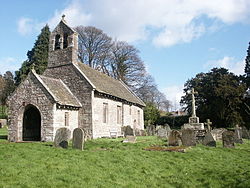Bettws Newydd: Difference between revisions
m Owain moved page Betws Newydd to Bettws Newydd |
No edit summary |
||
| (One intermediate revision by the same user not shown) | |||
| Line 10: | Line 10: | ||
|postcode=NP15 | |postcode=NP15 | ||
|dialling code=01291 | |dialling code=01291 | ||
|population= | |population=109 | ||
|census year= | |census year= | ||
|LG district=Monmouthshire | |LG district=Monmouthshire | ||
|constituency=Monmouth | |constituency=Monmouth | ||
}} | }} | ||
'''Bettws Newydd''' is a small village and ancient parish in [[Monmouthshire]] located about 3½ miles north of [[Usk]] and a few miles south of [[Clytha]] near [[Raglan]]. It forms part of the [[Raglan Hundred]]. | |||
'''Bettws Newydd''' is a small village and ancient parish in [[Monmouthshire]] located about 3½ miles north of [[Usk]] and a few miles south of [[Clytha]] near [[Raglan]]. | |||
== History == | == History == | ||
The site was originally an oratory or place of prayer and was founded by Saint Aedan of Ferns, who founded several churches in Wales and was also known as St Aidan of [[Llawhaden]]. As it was largely reconstructed in the 15th century as a new oratory it was referred to as Betws Newydd. | The site was originally an oratory or place of prayer and was founded by Saint Aedan of Ferns, who founded several churches in Wales and was also known as St Aidan of [[Llawhaden]]. As it was largely reconstructed in the 15th century as a new oratory it was referred to as Betws Newydd. | ||
| Line 26: | Line 24: | ||
On the surrounding hills are many tumuli or prehistoric burial mounds and at Coed-y-bwnydd meaning "the wood of the gentry" in the Welsh language (pronounced locally as 'Coed Bonnet'), is a large Iron Age hillfort with a massive mound protecting the entrance at the east and multi-vallate earthworks and entrenchments at that side, the other side being defended by a very steep incline. The wood and hillfort are in the care of the [[National Trust for Places of Historic Interest or Natural Beauty|National Trust]]. | On the surrounding hills are many tumuli or prehistoric burial mounds and at Coed-y-bwnydd meaning "the wood of the gentry" in the Welsh language (pronounced locally as 'Coed Bonnet'), is a large Iron Age hillfort with a massive mound protecting the entrance at the east and multi-vallate earthworks and entrenchments at that side, the other side being defended by a very steep incline. The wood and hillfort are in the care of the [[National Trust for Places of Historic Interest or Natural Beauty|National Trust]]. | ||
[[ | [[File:The Black Bear, Bettws Newydd - geograph.org.uk - 1432569.jpg|thumb|Black Bear pub]] | ||
== Amenities == | == Amenities == | ||
Latest revision as of 22:59, 7 January 2016
| Bettws Newydd | |
| Monmouthshire | |
|---|---|
 St Aeddan's church | |
| Location | |
| Grid reference: | SO361061 |
| Location: | 51°44’60"N, 2°55’37"W |
| Data | |
| Population: | 109 |
| Post town: | Usk |
| Postcode: | NP15 |
| Dialling code: | 01291 |
| Local Government | |
| Council: | Monmouthshire |
| Parliamentary constituency: |
Monmouth |
Bettws Newydd is a small village and ancient parish in Monmouthshire located about 3½ miles north of Usk and a few miles south of Clytha near Raglan. It forms part of the Raglan Hundred.
History
The site was originally an oratory or place of prayer and was founded by Saint Aedan of Ferns, who founded several churches in Wales and was also known as St Aidan of Llawhaden. As it was largely reconstructed in the 15th century as a new oratory it was referred to as Betws Newydd.
An old early Norman motte-and-bailey tump sits behind trees in the village next to the public house. St Aeddan's is 15th-century and a Grade I listed building.[1] It has a rare late mediæval rood screen and rood loft carved from oak. In the churchyard are two yew trees estimated to be 1,000 years old.
On the surrounding hills are many tumuli or prehistoric burial mounds and at Coed-y-bwnydd meaning "the wood of the gentry" in the Welsh language (pronounced locally as 'Coed Bonnet'), is a large Iron Age hillfort with a massive mound protecting the entrance at the east and multi-vallate earthworks and entrenchments at that side, the other side being defended by a very steep incline. The wood and hillfort are in the care of the National Trust.

Amenities
The village has a selection of property and a public house and restaurant with accommodation. A golf course is sited behind the pub.
Notes
References
- Monmouthshire, Its History and Topography, C.J.O. Evans, ~1950
Outside links
| ("Wikimedia Commons" has material about Newydd Bettws Newydd) |
